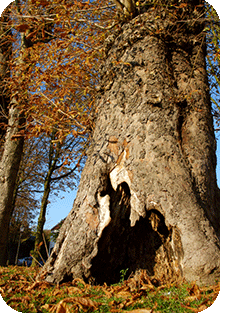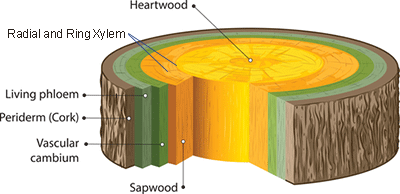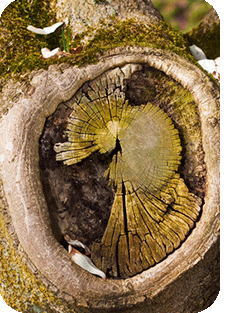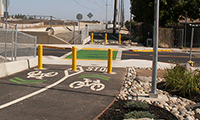Think Twice, Cut Once: Trees Can't Heal
Author: Chad Kennedy, Landscape Architect, ASLA
 I have fond memories of climbing trees dating as far back as I can remember. Whether to escape the relentless teasing from two older brothers, to obtain the last prized ripe cherry, to access the roof of the house, or to use as a natural jungle gym, trees were a valid participant of my childhood. At the ripe age of twelve, I had the unpleasant experience of falling out of a fruitless plum tree from within which I had been swinging. The result was an odd looking right forearm, two fractured bones and a worried mother. Due to the human body's amazing capacity for healing, in time, the arm healed and no lasting effects remain. As humans, we are familiar with this healing process and tend to think that it applies to nature in general. We use general statements about "healing" after natural disasters pretending that the process is universal throughout nature. Unfortunately, when it comes to trees in particular, the process is very different and assuming it is the same can be devastating to the longevity of trees, particularly in our urban forests. The truth is, trees cannot mend their wounds. Trees utilize a simple defensive approach of isolating and covering up damage to tissues. The image to the left illustrates damage to a tree that would have happened a very long time ago and, that most likely, seemed fairly benign at the time.
I have fond memories of climbing trees dating as far back as I can remember. Whether to escape the relentless teasing from two older brothers, to obtain the last prized ripe cherry, to access the roof of the house, or to use as a natural jungle gym, trees were a valid participant of my childhood. At the ripe age of twelve, I had the unpleasant experience of falling out of a fruitless plum tree from within which I had been swinging. The result was an odd looking right forearm, two fractured bones and a worried mother. Due to the human body's amazing capacity for healing, in time, the arm healed and no lasting effects remain. As humans, we are familiar with this healing process and tend to think that it applies to nature in general. We use general statements about "healing" after natural disasters pretending that the process is universal throughout nature. Unfortunately, when it comes to trees in particular, the process is very different and assuming it is the same can be devastating to the longevity of trees, particularly in our urban forests. The truth is, trees cannot mend their wounds. Trees utilize a simple defensive approach of isolating and covering up damage to tissues. The image to the left illustrates damage to a tree that would have happened a very long time ago and, that most likely, seemed fairly benign at the time.
Basic Tree Anatomy
In order to understand tree defense mechanisms, a basic understanding of tree anatomy is crucial. General tissues within a tree include the following:
Bark - A first line of defense and a protective outer layer covering the trunk, branches and stems.1
Cambium Layer - The layer of actively growing cells behind the bark layer. It is responsible for new growth of a tree including the phloem and xylem. Damage to this layer halts all growth in the damaged region.1
Phloem - The phloem is a vascular system of living cells that transport nutrients and water (sap) throughout the tree. In a sense they are a network of straws through which liquid is distributed throughout the tree. The phloem translocates nutrients both vertically and horizontally.1

Xylem - The xylem is a series of dead cells, commonly referred to as wood, that translocates primarily water. In contrast to the Phloem, it only transports water vertically.1
Containment vs. Healing
With this basic understanding of tree anatomy the concept of compartmentalization can be better understood. The term "healing" suggests that damage sustained by an object is mended and returned to its prior condition. When a tree sustains significant damage, it does not have the biological capacity to mend or return the damaged area to its original state. When damage occurs to a tree, the biological response is to contain the damage.  Using the vascular systems (xylem and phloem) as a structural framework, the tree creates vertical and horizontal walls around the damage by filling tissue between the cell wall and cell membranes with an insoluble, indigestible and very effective chemical called callose. 2 When this process occurs correctly pathogens are effectively contained by the barrier created and damage does not spread. In addition, the tree begins to create what is called wound wood (the light colored ring shown in the image to the left) which grows from the cambium layer at the edges of the wound and eventually closes over the damaged area creating the sixth and final wall of a natural containment chamber. When excessively large damage or incorrect pruning techniques occur, the walls and wound wood have difficulty forming, or may take a long time to form, allowing time and avenues for pathogen penetration. The ability for a tree to contain further damage is its only defense mechanism for long-term survival.
Using the vascular systems (xylem and phloem) as a structural framework, the tree creates vertical and horizontal walls around the damage by filling tissue between the cell wall and cell membranes with an insoluble, indigestible and very effective chemical called callose. 2 When this process occurs correctly pathogens are effectively contained by the barrier created and damage does not spread. In addition, the tree begins to create what is called wound wood (the light colored ring shown in the image to the left) which grows from the cambium layer at the edges of the wound and eventually closes over the damaged area creating the sixth and final wall of a natural containment chamber. When excessively large damage or incorrect pruning techniques occur, the walls and wound wood have difficulty forming, or may take a long time to form, allowing time and avenues for pathogen penetration. The ability for a tree to contain further damage is its only defense mechanism for long-term survival.
Pro-active Health
Just like humans, the healthier a tree is, the better it is able to respond to and contain damage and infection. If the tree is not allocating resources (nutrients & water) to fight other stress factors, such as water stress or insect attacks, it can quickly and efficiently perform biological functions to compartmentalize and stop expansion of any incurred damage. It is not always possible, however, to predict when damage may occur to a tree. A wise pro-active approach for minimizing future damage is the institution of regular maintenance, monitoring, watering, pest control and fertilizing programs. With these programs in place trees will be best prepared for stresses and will weather them better when they come.
Can you imagine yourself placing a permanent patch over a deep cut on your arm, knowing that it will never heal and that you may, or may not, have isolated any infection? In essence this is what trees do. So, before cutting a heart shape into a tree trunk, removing a branch or otherwise damaging a tree, think twice about the long-term effect this will have on the tree and cut only when necessary. When in doubt, contact a certified arborist who will be able to help you determine what is appropriate, how to keep a tree healthy, and how best to address past damage to a tree.
1.International Society of Arboriculture. ISA Dictionary Online. http://www.isa-arbor.com/education/onlineresources/dictionary.aspx . Accessed June 2014.
2.Freeman Brian, C. and Gwyn A. Beattie. An Overview of Plant Defenses against Pathogens and Herbivores. The Plant Health Instructor. DOI: 10.1094/PHI-I-2008-0226-01. https://www.apsnet.org/edcenter/intropp/topics/Pages/OverviewOfPlantDiseases.aspx Accessed June 2014.
 I have fond memories of climbing trees dating as far back as I can remember. Whether to escape the relentless teasing from two older brothers, to obtain the last prized ripe cherry, to access the roof of the house, or to use as a natural jungle gym, trees were a valid participant of my childhood. At the ripe age of twelve, I had the unpleasant experience of falling out of a fruitless plum tree from within which I had been swinging. The result was an odd looking right forearm, two fractured bones and a worried mother. Due to the human body's amazing capacity for healing, in time, the arm healed and no lasting effects remain. As humans, we are familiar with this healing process and tend to think that it applies to nature in general. We use general statements about "healing" after natural disasters pretending that the process is universal throughout nature. Unfortunately, when it comes to trees in particular, the process is very different and assuming it is the same can be devastating to the longevity of trees, particularly in our urban forests. The truth is, trees cannot mend their wounds. Trees utilize a simple defensive approach of isolating and covering up damage to tissues. The image to the left illustrates damage to a tree that would have happened a very long time ago and, that most likely, seemed fairly benign at the time.
I have fond memories of climbing trees dating as far back as I can remember. Whether to escape the relentless teasing from two older brothers, to obtain the last prized ripe cherry, to access the roof of the house, or to use as a natural jungle gym, trees were a valid participant of my childhood. At the ripe age of twelve, I had the unpleasant experience of falling out of a fruitless plum tree from within which I had been swinging. The result was an odd looking right forearm, two fractured bones and a worried mother. Due to the human body's amazing capacity for healing, in time, the arm healed and no lasting effects remain. As humans, we are familiar with this healing process and tend to think that it applies to nature in general. We use general statements about "healing" after natural disasters pretending that the process is universal throughout nature. Unfortunately, when it comes to trees in particular, the process is very different and assuming it is the same can be devastating to the longevity of trees, particularly in our urban forests. The truth is, trees cannot mend their wounds. Trees utilize a simple defensive approach of isolating and covering up damage to tissues. The image to the left illustrates damage to a tree that would have happened a very long time ago and, that most likely, seemed fairly benign at the time.
 Using the vascular systems (xylem and phloem) as a structural framework, the tree creates vertical and horizontal walls around the damage by filling tissue between the cell wall and cell membranes with an insoluble, indigestible and very effective chemical called callose. 2 When this process occurs correctly pathogens are effectively contained by the barrier created and damage does not spread. In addition, the tree begins to create what is called wound wood (the light colored ring shown in the image to the left) which grows from the cambium layer at the edges of the wound and eventually closes over the damaged area creating the sixth and final wall of a natural containment chamber. When excessively large damage or incorrect pruning techniques occur, the walls and wound wood have difficulty forming, or may take a long time to form, allowing time and avenues for pathogen penetration. The ability for a tree to contain further damage is its only defense mechanism for long-term survival.
Using the vascular systems (xylem and phloem) as a structural framework, the tree creates vertical and horizontal walls around the damage by filling tissue between the cell wall and cell membranes with an insoluble, indigestible and very effective chemical called callose. 2 When this process occurs correctly pathogens are effectively contained by the barrier created and damage does not spread. In addition, the tree begins to create what is called wound wood (the light colored ring shown in the image to the left) which grows from the cambium layer at the edges of the wound and eventually closes over the damaged area creating the sixth and final wall of a natural containment chamber. When excessively large damage or incorrect pruning techniques occur, the walls and wound wood have difficulty forming, or may take a long time to form, allowing time and avenues for pathogen penetration. The ability for a tree to contain further damage is its only defense mechanism for long-term survival.
